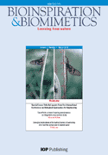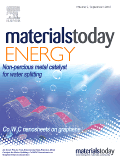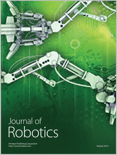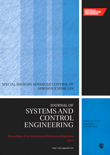
Bioinspiration & Biomimetics
Scope & Guideline
Innovative Insights from Nature’s Design
Introduction
Aims and Scopes
- Biomimetic Design and Engineering:
Research that applies biological principles to create innovative engineering solutions, including robotics, materials science, and structural design. - Soft Robotics and Adaptive Systems:
Exploration of soft robotic systems inspired by biological organisms, emphasizing adaptability, flexibility, and functionality in complex environments. - Fluid Dynamics and Bio-inspired Propulsion:
Studies on fluid dynamics as observed in nature, leading to advancements in propulsion systems for both aquatic and aerial vehicles. - Sensory and Actuation Mechanisms:
Investigating biological sensory systems and actuation methods to enhance robotic capabilities and human-robot interaction. - Ecological and Environmental Applications:
Utilizing bioinspired designs for sustainable solutions in environmental monitoring, energy harvesting, and ecological restoration.
Trending and Emerging
- Biohybrid Systems:
Integration of living organisms with robotic systems, highlighting advances in biohybrid technologies for applications in environmental monitoring and soft robotics. - Machine Learning and AI in Biomimetics:
Incorporation of machine learning and artificial intelligence to enhance robotic systems inspired by biological models, enabling adaptive and intelligent behavior. - Multi-modal and Soft Actuation Techniques:
Growing interest in soft actuators and multi-modal actuation strategies that mimic natural movements and interactions, leading to more versatile robotic designs. - Sustainability and Eco-friendly Solutions:
Increasing focus on sustainability through biomimetic designs that address environmental challenges, including energy-efficient systems and bio-inspired materials. - Complex Systems and Collective Behavior:
Investigation of collective behavior in biological systems and its application to robotic swarms, emphasizing cooperation and coordination in robotic designs.
Declining or Waning
- Traditional Robotics:
Research focused on conventional robotics that does not incorporate biological inspiration is becoming less prevalent as the field shifts towards more biomimetic approaches. - Static Structures:
Studies on static structures inspired by biology have decreased, with a growing emphasis on dynamic and adaptive systems that mimic living organisms. - Simple Mechanical Models:
The focus on simplistic mechanical models that lack bio-inspired complexity is waning, as researchers seek more biologically accurate models to address real-world challenges.
Similar Journals

Biomimetics
Harnessing Nature's Wisdom to Shape Advanced SolutionsBiomimetics, published by MDPI and based in Switzerland, is an esteemed open-access journal dedicated to the innovative exploration of biological principles and their applications in engineering and technology. With an E-ISSN of 2313-7673, this journal has been a vital platform for disseminating research since its inception in 2016, and it continues to promote collaborative interdisciplinary advancements through 2024 and beyond. Despite currently holding a Q3 ranking in Biochemistry, Bioengineering, Biomaterials, and Molecular Medicine, and a Q2 ranking in Biomedical Engineering and Biotechnology, its commitment to fostering impactful studies sets it apart in the scientific community. Researchers and professionals aiming to enhance their understanding of biomimetic applications can find a wealth of studies that bridge the gap between natural systems and technological innovation within its pages. The journal's open access format ensures that groundbreaking findings are readily accessible to a global audience, promoting knowledge sharing and collaboration across fields.

International Journal of Unconventional Computing
Challenging Norms, Redefining ComputingThe International Journal of Unconventional Computing, published by OLD CITY PUBLISHING INC, is a pivotal platform for innovative research within the field of Computational Science. With a significant focus on unconventional computing methods, this journal aims to explore new paradigms and approaches that challenge traditional computational models. Launched in 2008 and running through 2024, it has established itself as a noteworthy publication in its domain, currently categorized in the Q3 quartile for Computer Science (miscellaneous). While it holds a Scopus rank of #143 out of 232 in General Computer Science, the journal continues to attract submissions from a diverse range of scholars—fostering a rich dialogue on cutting-edge developments. As an essential resource for researchers, students, and professionals eager to delve into pioneering computing techniques, this journal invites the global academic community to contribute and engage with its content. Access options vary, promoting flexibility for readers interested in exploring unconventional methodologies in computing.

International Journal of Integrated Engineering
Advancing interdisciplinary innovation in engineering.International Journal of Integrated Engineering, published by UNIV TUN HUSSEIN ONN MALAYSIA, serves as a critical platform for disseminating research and advancements in the comprehensive field of integrated engineering. With an ISSN of 2229-838X, this journal is pivotal in enhancing interdisciplinary collaboration and innovation across numerous engineering domains, including Civil, Electrical, Mechanical, and Industrial Engineering. Although it currently holds various Q4 categories and competitors in the Scopus ranks, the journal consistently aims towards enhancing its impact and expanding its scope. Researchers can benefit from sharing their findings with a growing audience keen on the latest engineering developments. The journal emphasizes open access, making it a vital resource for academics, practitioners, and students alike who seek to stay informed about emerging trends and technologies in integrated engineering.

Materials Today Energy
Advancing Sustainable Solutions for Tomorrow's Energy NeedsMaterials Today Energy is a premier journal published by Elsevier, focusing on the interdisciplinary field of energy materials. With an ISSN of 2468-6069, the journal is renowned for its impactful research as evidenced by its impressive Q1 quartile rankings in multiple categories including Energy Engineering and Power Technology, Fuel Technology, and Renewable Energy. It stands out with strong Scopus rankings, highlighting its significance in the respective research communities, such as being ranked 3rd in Nuclear Energy and Engineering. Established from 2016 to 2024, the journal aims to provide a platform for innovative research that addresses the global demands for sustainable energy solutions. Although it is not open access, Materials Today Energy is accessible to a broad audience, encouraging collaborations among researchers, professionals, and students in the pursuit of advancing materials science and energy technologies. This makes it an essential resource for those looking to remain at the forefront of discoveries that shape the future of energy.

Journal of Robotics
Transforming Ideas into Robotic RealitiesJournal of Robotics, published by HINDAWI LTD, is a premier open-access journal dedicated to the rapidly evolving field of robotics. With its ISSN 1687-9600 and E-ISSN 1687-9619, the journal has been an essential resource for researchers, professionals, and students since its establishment in 2009. Based in England, the journal not only aims to disseminate cutting-edge research but also provides a platform for critical discussions on the latest advancements in robotics. Recognized for its quality, the journal holds a Q2 ranking in Computer Science (miscellaneous) and a Q3 ranking in Control and Systems Engineering for the year 2023. Spanning topics from autonomous systems to robotic engineering, the Journal of Robotics is indexed in various esteemed databases, making it a credible source for innovative research. The journal's commitment to open access ensures that its research reaches a broad audience, encouraging collaboration and driving forward the boundaries of technology and engineering.

JOURNAL OF INORGANIC BIOCHEMISTRY
Charting New Frontiers in Inorganic BiochemistryJOURNAL OF INORGANIC BIOCHEMISTRY, published by Elsevier Science Inc, is a pivotal journal dedicated to exploring the intricate intersections of biochemistry and inorganic chemistry. With an ISSN of 0162-0134 and an E-ISSN of 1873-3344, this esteemed journal has been a key resource since its inception in 1979, converging its insights through impactful research projections until 2024. Currently ranked #18 out of 79 in Inorganic Chemistry, placing it in the 77th percentile, and #144 out of 438 in Biochemistry, at the 67th percentile, the journal showcases a diverse array of studies that contribute significantly to understanding the roles of inorganic compounds in biological systems. Although it does not offer open access, the journal remains integral in fostering rigorous academic discourse among researchers and professionals keen on advancing the field. With a Category Quartile ranking of Q3 in Biochemistry and Q2 in Inorganic Chemistry, it serves as a critical platform for scholars aiming to disseminate cutting-edge findings and stimulate scholarly engagement in this dynamic area of study.

Annual Review of Control Robotics and Autonomous Systems
Pioneering Research in Control and Autonomous SystemsAnnual Review of Control Robotics and Autonomous Systems, published by ANNUAL REVIEWS, is a premier, peer-reviewed journal dedicated to advancing the field of control, robotics, and autonomous systems. With its E-ISSN of 2573-5144, the journal is recognized for its high-caliber contributions, evidenced by its Q1 ranking in key categories, including Artificial Intelligence, Control and Systems Engineering, and Human-Computer Interaction. Spanning converged years from 2018 to 2024, it serves as an essential resource for researchers, professionals, and students who seek to stay abreast of the latest developments and methodologies impacting these rapidly evolving fields. The journal does not currently offer Open Access options, which enables it to maintain stringent quality control while ensuring that every issue is packed with scholarly articles that meet the highest academic standards. With a focus on interdisciplinary approaches and cutting-edge technologies, the Annual Review of Control Robotics and Autonomous Systems is poised as a critical voice for scholarly discourse, fostering innovation and collaboration in tackling complex challenges of the modern world.

PROCEEDINGS OF THE INSTITUTION OF MECHANICAL ENGINEERS PART I-JOURNAL OF SYSTEMS AND CONTROL ENGINEERING
Elevating Engineering Knowledge for Tomorrow's ChallengesPROCEEDINGS OF THE INSTITUTION OF MECHANICAL ENGINEERS PART I - JOURNAL OF SYSTEMS AND CONTROL ENGINEERING is a prestigious journal published by SAGE Publications Ltd, dedicated to the fields of mechanical engineering and systems and control engineering. With an ISSN of 0959-6518 and an E-ISSN of 2041-3041, this journal has established a notable reputation since its conversion in 1991. It holds a solid Q2 ranking in both the Control and Systems Engineering and Mechanical Engineering categories as of 2023, placing it within the top cohort of its field based on Scopus rankings. This journal serves as a vital platform for researchers, professionals, and students, offering high-quality research articles, reviews, and technical notes that contribute to advancements in engineering practices and innovations. By focusing on the intersection of systems theory and mechanical applications, the journal aims to foster interdisciplinary collaboration and knowledge dissemination. As a premier outlet for scholarly work, it continues to drive progress in the engineering realm, ensuring the accessibility and relevance of cutting-edge research.

Soft Robotics
Exploring the Intersection of Nature and Technology in Robotics.Soft Robotics, published by MARY ANN LIEBERT, INC, stands as a leading journal dedicated to advancing the field of soft robotics, which merges insights from artificial intelligence, biophysics, and control systems engineering to innovate in areas such as bio-inspired design, human-robot interaction, and flexible robotics. With a distinguished Q1 ranking in multiple categories, including Artificial Intelligence, Biophysics, and Control and Systems Engineering, this journal places itself at the cutting edge of interdisciplinary research, boasting impressive Scopus rankings that reflect its rigorous scholarship and influential contributions to the scientific community. Although it is not an open access journal, it provides valuable insights and findings for researchers, professionals, and students eager to explore the transformative potential of soft robotics in practical applications. The journal has published continuously since its inception in 2014, and will continue to converge between theory and application through 2024, emphasizing its commitment to expanding the frontiers of knowledge in this dynamic field. For those engaged in the exploration of robotics technologies shaped by soft materials and adaptive mechanisms, Soft Robotics is an essential resource that fuels innovation and discovery.

RESEARCH ON CHEMICAL INTERMEDIATES
Illuminating Pathways in Chemical IntermediatesRESEARCH ON CHEMICAL INTERMEDIATES, published by Springer, is a prestigious academic journal that has been contributing to the field of chemistry since 1984. With an ISSN of 0922-6168 and an E-ISSN of 1568-5675, this journal serves as a vital platform for the dissemination of innovative findings and research advancements related to chemical intermediates. Situated in the Netherlands, it has established a commendable reputation, currently ranked in the Q2 category for miscellaneous chemistry and positioned at #131/408 with a 68th percentile in the Scopus rankings. Though it does not operate under an open-access model, the journal plays a crucial role in connecting scientists, researchers, and practitioners to facilitate a better understanding of synthetic methods, characterizations, and applications of various chemical intermediates. Continually publishing high-quality research until its anticipated convergence in 2024, this journal is an essential resource for those looking to expand their knowledge and contribute to the vibrant community of chemical science.